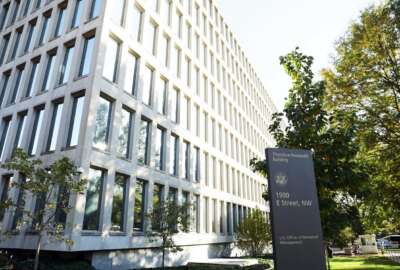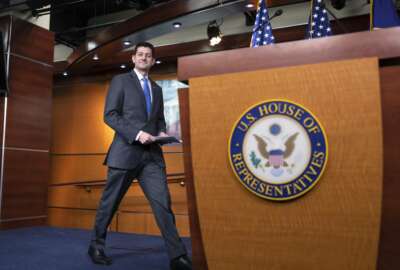
Perfect time to approach your lawmaker
Many who have been comfortably stationed in Washington for decades are literally running for their political lives this year.
Workers and retirees worried about pay and pensions have seven days left to catch their member of Congress at his or her most vulnerable location: Their home district. There, people like you will decide Nov. 6 whether they get to come back to Washington for another two-year term. Members of the House of Representatives have had a lot of time off this year and many of their seats are up for grabs, literally.
Groups representing feds, whether retired, rank-and-file, management or postal employees say this is the best week to get up-close and personal to otherwise often remote politicians. It can be via telephone, Twitter or at a political rally. Many who have been comfortably stationed in Washington for decades are literally running for their political lives this year.
The point is, catch them while they are hot, as in sweating, on your turf. You may love it where you live but they desperately want to come back here.
Most Washington-based politicians probably realize that feds, retirees and family members don’t like the idea of a 2019 pay freeze. Or of major reductions in their Civil Service Retirement System and Federal Employees Retirement System retirement benefits that would have most active workers paying more now for reduced benefits when they retire. What many if not most do not know is how many active and retired feds live in their home towns or congressional districts and vote.
Although Washington is the center of the infamous bureaucratic swamp the president has promised to dismantle and drain, the fact is that 86 percent pf federal government workers do not live, work or vote in the sprawling D.C. metro area. It includes the District of Columbia, portions of Maryland, Virginia and a tiny sliver of West Virginia. D.C. is 98 percent Democratic and Maryland’s three biggest counties are usually safely in the Democratic camp. But even nearby Northern Virginia, home to the CIA, Pentagon and other major federal operations is politically purple and trending Democratic.
Outside of Washington, in places like California, Texas, Florida, New York and Illinois there are large concentrations of federal workers and former feds. They all have an interest in things such as pay raises, inflation-protected annuities and health premiums that always go up regardless. Colorado has a huge number of feds for its population, as do Alabama, Hawaii, Georgia, North Carolina, South Carolina and Utah and Alaska.
Think about the biggest employer in your congressional district. If there is a Veterans Affairs Department hospital or an IRS or U.S. Postal Service center, an Army, Navy, Air Force, Marine Corps or Coast Guard facility, or even a federal prison, then Uncle Sam may be the chief dispenser of paychecks. Try to think of an area where the government is not one of the leading employers.
So what’s at stake? Some would say only your future and your standard of living. Here is list of items on the White House-congressional hit list the National Active and Retired Federal Employees supplied its members. But it applies to anybody else in government, or retired from government including people like you. NARFE said it represents $152.5 billion, with a B, out of your hide:
- Eliminating cost of living adjustments for current and future Federal Employees Retirement System (FERS) retirees.
- Reducing COLAs for CSRS retirees by 0.5 percent each year from what it would have been otherwise. When combined with the elimination of the FERS COLA, this would cost federal retirees $50.2 billion over 10 years, and much more thereafter.
- Federal employees covered under FERS would see employee contributions to their annuities increased by 1 percent each year for the next six years, without any corresponding benefit increase. This will cost FERS employees $68.7 billion over the next 10 years, and more thereafter.
- The earned and fully funded FERS Annuity Supplement would be eliminated for new retirees. This would cost federal retirees $18.7 billion over the next 10 years.
- Reducing the rate of return on the Thrift Savings Plan’s Government Securities Investment (G) Fund. This would cost federal employees and retirees, as well as military personnel and veterans, $8.9 billion over the next 10 years.
- Federal pensions for new retirees would be based on the average of the highest five years of salary instead of the highest three. This would cost federal retirees $5.9 billion over the next 10 years.
- Freezing federal employee pay in calendar year 2019.
- Reduction of total paid time off by combining sick and annual leave into one pool. This proposal has the potential to decrease annuities, as unused sick leave is counted towards creditable service.
- Reducing working and retirement-age benefits for federal workers disabled through their service ($117 million over 10 years).
Nearly Useless Factoid
By Amelia Brust
Crows have been found to demonstrate social learning in their encounters with humans. In a series of experiments at the University of Washington, the birds could discriminate among individual people and remembering those who have aided or threatened them in the past, and would scorn the latter group.
Source: NIH
Copyright © 2025 Federal News Network. All rights reserved. This website is not intended for users located within the European Economic Area.
Mike Causey is senior correspondent for Federal News Network and writes his daily Federal Report column on federal employees’ pay, benefits and retirement.
Follow @mcauseyWFED





